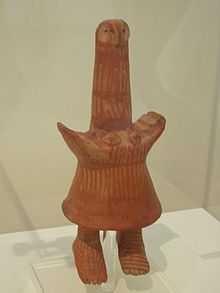Daidala

The daidala is a type of sculpture attributed to the legendary Greek artist, Daedalus, who is connected in legend both to Bronze Age Crete and to the earliest period of Archaic sculpture in Bronze Age Greece. The legends about Daedalus recognize him both as a man and as a mythical embodiment. He was the reputed inventor of agalmata, statues of the gods which had open eyes and moveable limbs,[1] a compelling manifestation of the mystery of divinity (the verb "to see" was reciprocal in Greek: whoever saw was also seen, and the blind were invisible). These statues were so lifelike that Plato remarked upon their amazing and disconcerting mobility, which was accomplished with techniques that are clearly those of the "daidala". The writer Pausanias thought that wooden images were referred to as "daidala" even before Daedalus’s time.[2] The name "Daedalus", more specifically, has been suggested by Perez-Gomez to be a play on the Greek word "daidala" which appears in archaic literature as a complement of the verb "to make", "to manufacture", "to forge", "to weave", "to place on", or "to see". Daidala were the implements of early society: defensive works, arms, furniture, and so forth.[3]
Daedalic sculpture reveals Eastern influences, known as Orientalizing Period in Greek art. Orientalizing is particularly noticeable in the head seen from the front; it resembles an Eastern head, with wiglike hair, but is more angular, having a triangular face, large eyes, and a prominent nose. The female body is rather flatly geometric, with high waist and formless drapery. Early sculpture exhibiting these attributes is known as "Daedalic"; it was used for figurines, on clay plaques, and in relief decorations on vases. It seems to have had a marked influence in the Peloponnese, Dorian Crete, and Rhodes. Its style is based on a simple formula which remained dominant, though with evolutionary modifications, for about two generations, before evolving into the Archaic style.
References
- ↑ Donohue, Alice A. (1988). Xoana and the origins of Greek sculpture. Scholars Press. p. 182.
- ↑ Pausanias (1794). The Description of Greece, Volume 3. London: R. Faulder. p. 6.
- ↑ Smith, Albert C. The Monster and Daedalus. Ryerson University. p. 2.
Further reading
- Sarah P. Morris, Daidalos and the Origins of Greek Art, Princeton, 1992
External links
-
 Media related to Daidala at Wikimedia Commons
Media related to Daidala at Wikimedia Commons